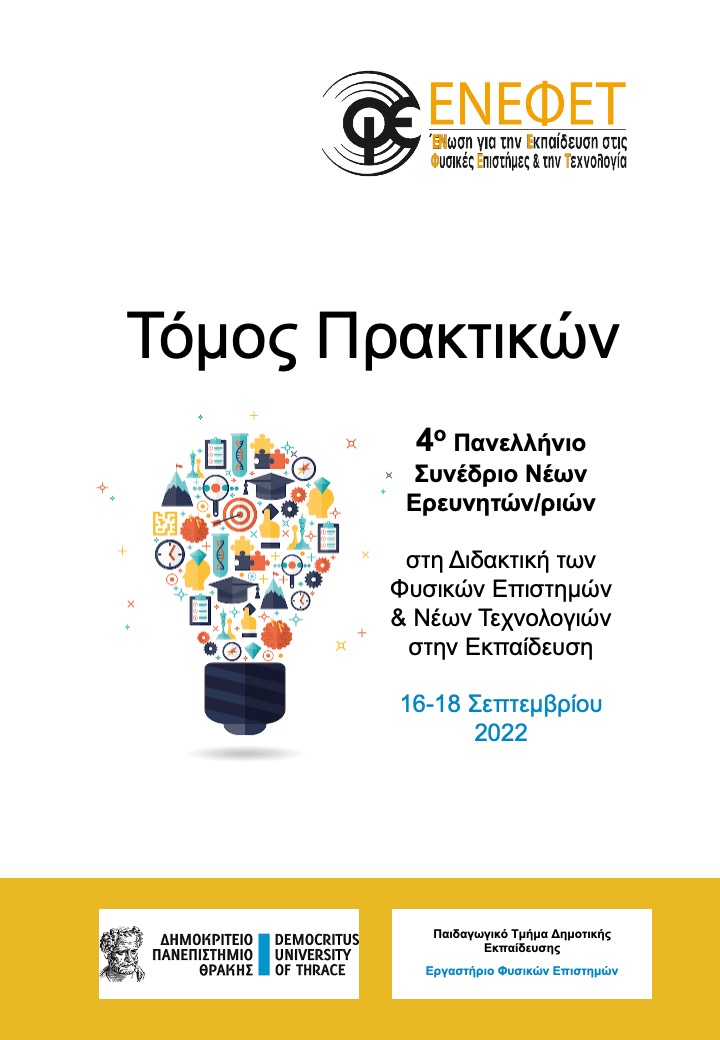ΣΧΕΔΙΑΣΜΟΣ, ΑΝΑΠΤΥΞΗ, ΕΦΑΡΜΟΓΗ ΚΑΙ ΑΞΙΟΛΟΓΗΣΗ ΜΙΑΣ ΔΜΑ ΓΙΑ ΤΗ ΔΙΑΔΟΣΗ ΤΗΣ ΘΕΡΜΟΤΗΤΑΣ ΜΕ ΑΓΩΓΗ ΜΕ ΣΤΟΧΟ ΤΗ ΔΙΕΡΕΥΝΗΣΗ ΤΩΝ ΜΑΘΗΣΙΑΚΩΝ ΜΟΝΟΠΑΤΙΩΝ ΤΩΝ ΜΑΘΗΤΩΝ

Published:
Sep 14, 2024
Keywords:
teaching learning sequence learning pathways teaching experiment heat primary education
Abstract
The purpose of this study is the design, development, implementation and evaluation of a TLS for the mechanism of heat conduction in the 5th grade of Primary School. Ultimate aim is to capture students’ learning pathways in this thematic area. The sequence was implemented to small group of students with the teaching experiment method. Participants were 12 students of 5th grade. The teaching experiments were videotaped and recorded. Qualitative methods of content analysis are used to analyze the data. In this paper the design of the first teaching experiment, as well as first results from its analysis are presented.
Article Details
- Section
- ΜsCs
- Categories
References
Erickson, G. (1980). Children’s viewpoints of heat: A second look. Science Education, 64(3), 323-336.
Erickson, F. (2012). Qualitative Research Methods for Science Education. In B. J. Fraser, K. G. Tobin, C. McRobbie (Eds.), Second International Handbook of Science Education (pp. 1451-1469). Springer: Kluwer. https://doi.org/10.1007/978-1-4020-9041-7
Hatzikraniotis, E., Kallery, M., Moloxidis, A., & Psillos, D. (2010). Students’ design of experiments: an inquiry module on the conduction of heat. Physics Education, 45, 335-344. https://doi.org/10.1088/0031-9120/45/4/002
Kesidou, S., & Duit, R. (1993). Students' conceptions of the second law of thermodynamics: An interpretive study. Journal of Research in Science Teaching, 30(1), 85-106.
Komorek, M., & Duit, R. (2004). The teaching experiment as a powerful method to develop and evaluate teaching and learning sequences in the domain of non-linear systems. International Journal of Science Education, 26(5), 619-633. https://doi.org/10.1080/09500690310001614717
Schönborn, K., Haglund, J., & Xie, C. (2014). Pupils’ early explorations of thermoimaging to interpret heat and temperature. Journal of Baltic Science Education, 13(1), 118-132.
She, H.-C. (2004). Fostering radical conceptual change through dual-situated learning model. Journal of Research in Science Teaching, 14(2), 142-164. https://doi.org/10.1002/tea.10130
Yeo, J., Wong, W., Tan, D., Ong, Y., & Pedregosa A. (2020). Using visual representations to realize the concept of “heat”. Learning: Research and Practice, 6(1), 34-50.





